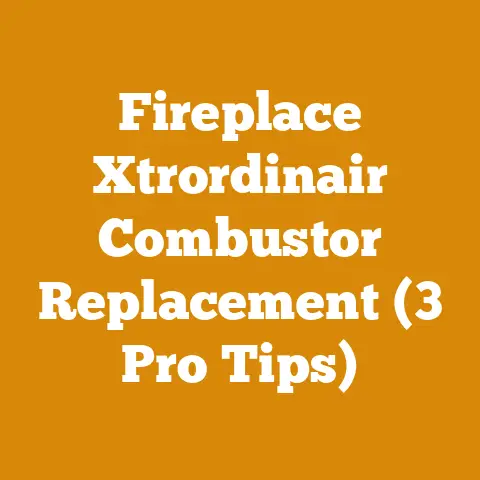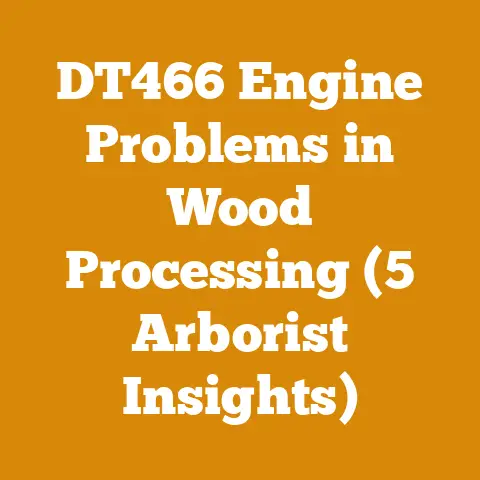Does a Wood Stove Give Off Carbon Monoxide? (Draft & Vent Insights)
Let’s talk about smart homes for a moment. We’re all striving for that perfect blend of comfort, efficiency, and safety, right? Think about it: automated lighting, smart thermostats, and security systems all working in harmony. But what about the heart of many homes, especially during those chilly months – the wood stove? It’s a comforting source of heat, but it also introduces a potential hazard: carbon monoxide (CO). Understanding the risks associated with wood stoves and carbon monoxide is crucial for maintaining a safe and healthy home environment, especially when you’re aiming for that smart, secure living space. Let’s dive deep into how wood stoves work, the dangers of CO, and how to keep your home safe.
Does a Wood Stove Give Off Carbon Monoxide? (Draft & Vent Insights)
The short answer is yes, wood stoves do give off carbon monoxide. CO is a byproduct of incomplete combustion – meaning when wood doesn’t burn completely. Several factors influence how much CO a wood stove produces, including the stove’s design, the type of wood you burn, and, most importantly, the quality of the draft and venting system. I’ve seen firsthand how a poorly maintained or improperly installed wood stove can quickly become a silent threat.
Understanding Carbon Monoxide (CO)
Carbon monoxide is a colorless, odorless, and tasteless gas. This makes it incredibly dangerous because you can’t detect it with your senses. It’s produced when fuels like wood, propane, natural gas, or oil don’t burn completely. When you inhale CO, it replaces oxygen in your bloodstream, leading to oxygen deprivation in your brain and vital organs.
The Dangers of CO Exposure
Even low levels of CO exposure can cause flu-like symptoms such as headaches, dizziness, nausea, and fatigue. Higher concentrations can lead to loss of consciousness, brain damage, and even death. Children, pregnant women, the elderly, and people with heart or respiratory problems are particularly vulnerable to CO poisoning.
I remember a time when a neighbor of mine dismissed a persistent headache as “just a cold.” It turned out their wood stove was leaking CO, and they were lucky to catch it before it became a serious situation. That incident really hammered home the importance of CO awareness and prevention.
How Wood Stoves Produce CO
Wood stoves burn wood to generate heat. Ideally, this combustion process should be complete, producing primarily carbon dioxide (CO2) and water vapor. However, incomplete combustion occurs when there’s not enough oxygen, the temperature isn’t high enough, or the fuel (wood) is damp. This incomplete combustion results in the production of carbon monoxide.
Draft: The Engine of Combustion
The draft in your wood stove system is essentially the engine that drives the combustion process. It’s the flow of air that enters the stove, feeds the fire, and carries the exhaust gases up the chimney. A good draft is critical for efficient burning and minimizing CO production.
How Draft Works
Draft is created by the difference in air pressure between the inside of the stove and the outside air. Hot air rises, creating a vacuum that pulls fresh air into the stove through the air inlets. This airflow provides the oxygen needed for combustion. The hotter the fire and the taller the chimney, the stronger the draft.
Factors Affecting Draft
Several factors can influence the draft in your wood stove system:
- Chimney Height: A taller chimney creates a stronger draft. Building codes usually specify minimum chimney heights.
- Chimney Diameter: The chimney diameter must match the stove’s outlet size. Too small and it will restrict airflow; too large and it can cool the gases, reducing draft.
- Chimney Location: Chimneys located on the outside walls of a house are more prone to cold temperatures, which can reduce draft.
- Outside Temperature: Cold outside temperatures increase the temperature difference, resulting in a stronger draft.
- Wind Conditions: Wind can affect draft, sometimes positively and sometimes negatively. Strong winds blowing across the chimney top can create a downdraft, pushing exhaust gases back into the stove.
- Obstructions: Bird nests, creosote buildup, and other obstructions in the chimney can significantly reduce draft.
I once helped a friend troubleshoot a smoky wood stove problem. After checking everything else, we discovered a bird’s nest blocking the chimney. Removing the nest immediately restored the draft and eliminated the smoke.
Troubleshooting Draft Issues
If you’re experiencing problems with your wood stove’s draft, here are some troubleshooting steps:
- Check for Obstructions: Inspect the chimney for bird nests, creosote buildup, or other obstructions. A chimney sweep can perform a professional inspection and cleaning.
- Ensure Proper Chimney Height and Diameter: Verify that your chimney meets the manufacturer’s specifications for your stove.
- Warm Up the Chimney: Cold chimneys can inhibit draft. Before starting a fire, try holding a lit torch or newspaper up the chimney to warm it up.
- Adjust Air Inlets: Experiment with adjusting the air inlets on your stove to find the optimal setting for your specific situation.
- Consider a Chimney Extension: If your chimney is too short, adding a section can improve draft.
- Install a Chimney Cap: A chimney cap can prevent rain and debris from entering the chimney and also help to reduce downdrafts caused by wind.
Takeaway: A strong, consistent draft is essential for efficient wood stove operation and minimizing CO production. Regular chimney inspections and maintenance are crucial.
Venting: Getting Rid of the Bad Stuff
Venting refers to the system that carries the exhaust gases, including carbon monoxide, away from your wood stove and out of your home. A properly designed and maintained venting system is vital for preventing CO poisoning.
Components of a Venting System
A typical wood stove venting system consists of the following components:
- Stovepipe: The stovepipe connects the wood stove to the chimney. It’s usually made of single-wall or double-wall steel.
- Chimney: The chimney is the vertical structure that carries the exhaust gases up and out of the house. It can be made of masonry (brick or stone) or metal (stainless steel).
- Chimney Liner: A chimney liner is a metal or ceramic tube that runs inside the chimney. It protects the chimney from the corrosive effects of flue gases and improves draft.
- Chimney Cap: The chimney cap covers the top of the chimney, preventing rain and debris from entering.
Proper Venting Practices
Here are some best practices for ensuring proper venting:
- Use the Correct Size Stovepipe: The stovepipe diameter should match the stove’s outlet size. Never reduce the diameter of the stovepipe.
- Maintain Proper Clearance: Ensure that the stovepipe and chimney have adequate clearance from combustible materials such as walls, ceilings, and roofs. Consult the stove manufacturer’s instructions and local building codes for specific clearance requirements.
- Use the Right Type of Stovepipe: Single-wall stovepipe is less expensive but radiates more heat, requiring greater clearances. Double-wall stovepipe provides better insulation and requires less clearance.
- Install a Chimney Liner: If you have a masonry chimney, a chimney liner is highly recommended. It protects the chimney from corrosion and improves draft.
- Seal All Connections: Ensure that all connections between the stove, stovepipe, and chimney are tightly sealed to prevent leaks. Use high-temperature silicone sealant to seal joints.
- Regularly Inspect and Clean the Venting System: Inspect the stovepipe and chimney for signs of damage, corrosion, or creosote buildup. Clean the venting system at least once a year, or more often if you burn a lot of wood.
I’ve seen situations where homeowners tried to save money by using undersized or damaged stovepipe. This is a dangerous shortcut that can lead to CO leaks and house fires. Always prioritize safety and follow the manufacturer’s recommendations.
Common Venting Problems
Here are some common venting problems to watch out for:
- Creosote Buildup: Creosote is a flammable substance that forms when wood smoke condenses in the chimney. Excessive creosote buildup can lead to chimney fires.
- Corrosion: Flue gases can corrode metal stovepipes and chimney liners over time.
- Leaks: Leaks in the stovepipe or chimney can allow CO to escape into the house.
- Downdrafts: Downdrafts can push exhaust gases back into the stove, causing smoke and CO to enter the room.
- Blockages: Bird nests, debris, and collapsed chimney liners can block the venting system.
Takeaway: Proper venting is crucial for safely removing exhaust gases from your home. Regular inspections, cleaning, and maintenance are essential.
Wood Quality: The Fuel for the Fire
The type and quality of wood you burn significantly impact the amount of CO produced by your wood stove. Burning seasoned (dry) wood is essential for efficient combustion and minimizing CO emissions.
The Importance of Seasoned Wood
Seasoned wood has a moisture content of 20% or less. When you burn seasoned wood, it ignites easily, burns hotter, and produces less smoke and creosote. Unseasoned (wet) wood contains a high moisture content, which requires more energy to burn off. This results in a cooler fire, incomplete combustion, and increased CO production.
I always tell people that burning wet wood is like trying to run a car on water. It’s inefficient, produces a lot of smoke, and can damage your engine (in this case, your wood stove and chimney).
Identifying Seasoned Wood
Here are some ways to identify seasoned wood:
- Check the Moisture Content: Use a moisture meter to measure the moisture content of the wood. Aim for a reading of 20% or less. You can buy a moisture meter at most hardware stores for around $20-$50.
- Look for Cracks: Seasoned wood typically has cracks in the end grain.
- Check the Weight: Seasoned wood is lighter than unseasoned wood.
- Listen for a Hollow Sound: When you knock two pieces of seasoned wood together, they should sound hollow.
- Observe the Color: Seasoned wood tends to be gray or brownish in color.
Seasoning Wood Properly
To season wood properly, follow these steps:
- Split the Wood: Splitting the wood exposes more surface area, allowing it to dry faster.
- Stack the Wood: Stack the wood in a single row, off the ground, with space between the rows for air circulation.
- Cover the Wood: Cover the top of the woodpile with a tarp to protect it from rain and snow, but leave the sides open for ventilation.
- Allow Sufficient Time: Allow the wood to season for at least six months, or preferably a year or more. The seasoning time will depend on the type of wood and the climate.
I usually start preparing my firewood a year in advance. This gives the wood plenty of time to dry out completely, ensuring a clean and efficient burn.
Best Wood Types for Burning
Some wood types burn hotter and cleaner than others. Here are some of the best wood types for burning in a wood stove:
- Hardwoods: Oak, maple, ash, birch, and beech are all excellent choices. They are dense, burn slowly, and produce a lot of heat.
- Softwoods: Pine, fir, and spruce are less dense than hardwoods and burn faster. They can be used for kindling or starting fires, but they are not ideal for sustained burning.
Avoid burning treated wood, painted wood, or wood that has been exposed to chemicals. These materials can release toxic fumes when burned.
Takeaway: Burning seasoned wood is essential for efficient combustion and minimizing CO production. Choose hardwoods for sustained burning and avoid burning treated or contaminated wood.
Stove Maintenance: Keeping it Running Smoothly
Regular maintenance is crucial for ensuring that your wood stove operates safely and efficiently. A well-maintained stove will burn cleaner and produce less CO.
Regular Inspection
Inspect your wood stove regularly for signs of damage or wear. Check the door seals, gaskets, and air inlets for leaks. Make sure the stovepipe and chimney are free of obstructions.
Cleaning
Clean your wood stove regularly to remove ash and creosote. Ash buildup can reduce airflow and affect combustion. Creosote buildup can lead to chimney fires.
- Ash Removal: Remove ash from the firebox regularly, using a shovel and ash bucket. Dispose of the ash properly.
- Creosote Removal: Inspect the stovepipe and chimney for creosote buildup. If you find significant buildup, have the venting system professionally cleaned.
I make it a habit to clean out the ash every few days during the heating season. It only takes a few minutes, and it helps to keep the stove burning efficiently.
Repairing
Repair any damaged or worn parts promptly. Replace cracked firebricks, worn-out gaskets, and leaky door seals. A properly sealed stove will burn more efficiently and produce less CO.
Professional Servicing
Have your wood stove professionally serviced at least once a year. A qualified technician can inspect the stove, clean the venting system, and make any necessary repairs.
Takeaway: Regular maintenance is essential for safe and efficient wood stove operation. Inspect, clean, and repair your stove regularly, and have it professionally serviced at least once a year.
Carbon Monoxide Detectors: Your Silent Guardians
Carbon monoxide detectors are essential safety devices that can alert you to the presence of CO in your home. They are relatively inexpensive and easy to install.
Types of CO Detectors
There are two main types of CO detectors:
- Electrochemical Sensors: These detectors use a chemical reaction to measure the concentration of CO in the air. They are generally more accurate and reliable than other types of detectors.
- Biomimetic Sensors: These detectors use a gel that changes color in the presence of CO. They are less expensive but may be less accurate.
Installation and Placement
Install CO detectors on every level of your home, especially near sleeping areas. Follow the manufacturer’s instructions for placement and installation. Avoid placing detectors near windows, doors, or vents, as drafts can affect their accuracy.
I recommend installing a CO detector in every bedroom, as well as one in the hallway outside the bedrooms. This provides maximum protection for your family.
Maintenance and Testing
Test your CO detectors regularly to ensure that they are working properly. Most detectors have a test button that you can press to activate the alarm. Replace the batteries in your detectors at least once a year, or as recommended by the manufacturer. Replace the entire detector every five to seven years, or as recommended by the manufacturer.
Responding to an Alarm
If your CO detector goes off, take the following steps:
- Evacuate: Immediately evacuate everyone from the house.
- Call for Help: Call the fire department or 911 from a safe location.
- Do Not Re-enter: Do not re-enter the house until the fire department has determined that it is safe to do so.
- Identify the Source: Once it’s safe to return, have your wood stove and venting system inspected by a qualified technician to identify and correct the source of the CO leak.
Takeaway: Carbon monoxide detectors are essential safety devices that can alert you to the presence of CO in your home. Install detectors on every level of your home, test them regularly, and replace the batteries annually.
Building Codes and Regulations
Building codes and regulations play a crucial role in ensuring the safe installation and operation of wood stoves. These codes specify requirements for chimney height, clearances, venting, and other safety aspects.
Local Building Codes
Consult your local building codes before installing a wood stove. These codes may vary depending on your location. Your local building department can provide information on the specific requirements in your area.
National Fire Protection Association (NFPA) Standards
The National Fire Protection Association (NFPA) publishes standards for the installation and operation of wood stoves. These standards are widely adopted by building codes and provide detailed guidance on safety practices.
Insurance Requirements
Your homeowner’s insurance policy may have specific requirements for wood stove installation and operation. Check with your insurance company to ensure that you are in compliance with their requirements.
I always advise homeowners to obtain the necessary permits and inspections before installing a wood stove. It’s a small price to pay for peace of mind and the assurance that your installation meets safety standards.
Takeaway: Comply with all applicable building codes and regulations when installing and operating a wood stove. This will help to ensure your safety and protect your property.
Case Studies: Learning from Experience
Real-world case studies can provide valuable insights into the dangers of CO poisoning and the importance of proper wood stove safety practices.
Case Study 1: The Silent Killer
A family of four was found unconscious in their home after being exposed to high levels of CO. The source of the CO was a poorly maintained wood stove. The chimney was blocked with creosote, preventing exhaust gases from escaping. The family was lucky to survive, but they suffered long-term health effects from the CO poisoning.
Case Study 2: A Close Call
A homeowner experienced flu-like symptoms for several days. He suspected that he had a cold, but he decided to check his CO detector just in case. The detector was alarming, indicating a high level of CO in the home. He evacuated the house and called the fire department. The fire department found a crack in the stovepipe, which was leaking CO into the house. The homeowner was able to avoid serious injury thanks to his CO detector.
Case Study 3: Prevention is Key
A homeowner had his wood stove and chimney professionally inspected and cleaned every year. He also burned seasoned wood and maintained his stove properly. As a result, he never experienced any problems with CO poisoning.
These case studies highlight the importance of regular maintenance, proper venting, and the use of CO detectors. They also demonstrate that CO poisoning can happen to anyone, regardless of their experience with wood stoves.
Takeaway: Learn from the experiences of others and take proactive steps to prevent CO poisoning in your home.






